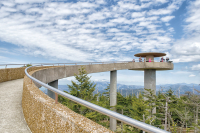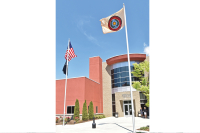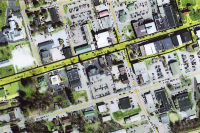Putting Panthertown on the map
Every hiker has likely named a trailside feature or two in their day. Ferns sprouting from the banks of a waterfall give rise to Fern Falls, or a flat granite outcrop stumbled upon mid-day becomes the ever-descriptive Lunch Rock.
For most of us, the names fade into oblivion, but for a lucky few, the names they come up with are committed to paper and adopted by hikers everywhere — especially if you’re the guy making the map.
“When you map a place you get to name things,” said Burt Kornegay, owner of Slickrock Expeditions.
Such was the case for Panthertown, the bowl-like valley flanked by granite domes, known as Yosemite of the East. It perches on the Cashiers plateau, its waterfall-laden streams feeding the headwaters of the Tuckasegee River. It was once considered a “best-kept secret,” with a maze of unmarked trails, unnamed waterfalls and uncluttered campsites.
It’s safe to say Panthertown has been discovered, witnessed by the 15,000 maps Kornegay has sold of Panthertown in the past decade. His map was the first and only one depicting the trails, and as a result, he got to name stuff, lots of stuff — like the previously unnamed Jawbone Falls.
“The first time I ever walked out on it there was a beaver jaw laying on the rock. So that’s how I started referring to it,” Kornegay said.
Related Items
He can also take credit for Halfway Falls, which, incidentally, is halfway between Greenland Falls and Carlton Falls.
Kornegay used intuitive names when possible. A waterfall that empties into a giant pothole in the rock below was plainly named Pothole Falls. Names bestowed on trails usually pay homage to natural features along their route, like the West Fork Way trail, which follows the West Fork of the French Broad River in the Big Pisgah portion of Panthertown.
Kornegay also named the massive granite wall known as the “Great Wall of Panthertown” and the trail known as the Great Wall Trail.
When Kornegay first began naming things in Panthertown, his motive wasn’t map-making. It was simply to communicate with the handful of other hikers who, like Kornegay, enjoyed Panthertown as their own personal backyard playground.
“When you tell someone ‘I’ll see you at such and such falls,’ you better be talking about the same place,” Kornegay said.
Of course, some people had adopted their own names for the same place. Kornegay can think of half a dozen names people still use to refer to one waterfall — a product of the hiker’s paradise lacking an official map for so long.
Kornegay’s first maps of Panthertown were mere line drawings, sketched in on a standard issue USGS topo map to help him remember where he’d been and where he had yet to explore.
The area known as Panthertown was largely a big blank spot.
As luck would have it, Panthertown didn’t fall neatly within one USGS quadrant. He had to piece together the corners of four maps to replicate Panthertown.
Kornegay could have kicked back at his kitchen table with a cup of tea and drawn all the trails from memory.
“I had been hiking them for years by then,” Kornegay said.
But for good measure, Kornegay hiked the trails and drew them in as he went.
He ran off 100 copies on a color copier, mostly to share with clients on his guided outfitter trips. But word soon got out in the hiking community that someone had made a map of Panthertown trails, and they’ve sold like hotcakes ever since.
For the first time in 12 years, Kornegay has updated the map and released a new and improved version. There’s only one downside, for him anyway. It’s made out of tear-proof, waterproof paper.
“These ones won’t wear out. It’s going to hurt sales,” Kornegay said.
While Kornegay’s map was the only one out there for years, the forest service has recently come out with a map of its own. Kornegay’s map is more detailed, however, showing several trails and waterfalls that don’t appear on the forest service one.
When making a map, the forest service didn’t have the knowledge base of Kornegay and his Panthertown comrades. They were unfamiliar with colloquial names assigned to various knobs, trails, creeks and the like.
So a map naming session was convened with several Panthertown experts to hash out official names for the forest service map.
The meeting of the minds managed to label the final handful of features that still lacked a name — including the final unnamed waterfall of Panthertown’s wilds.
“Someone said ‘That’s near Mac’s Gap, Let’s call it Mac’s Falls,’” Kornegay said.
Want to hike Panthertown?
Trail maps of Panthertown Valley can be purchased for $12 at Blackrock Outdoors and City Lights in Sylva or Highland Hiker in Highlands. Or go to www.slickrockexpeditions.com.
Dubbed the “Guide’s Guide to Panthertown, Bonas Defeat and Big Pisgah,” the name is a throwback to the map’s author Burt Kornegay, an outdoor guide who frequently leads trips in Panthertown.
To reach Panthertown, you have to take side roads off N.C. 107 or N.C. 281 in southern Jackson County. Directions to the parking areas are found in the map. The back of the map has a detailed explanation of Panthertown’s natural and human history, along with suggestions for possible hikes.













